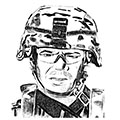
The first area of opportunity appeared to be a cluster of 3 villages. A fire base was planned central to those three and an immediate effort was made to set up a flight corridor for safe egress. Cav dispatched infantry to nearby villages with LZs and ground units pushed into the nearby jungle. When a comfortable level of security could be assured, engineers moved in to clear LZs next to the nearer village and deforest a site for the fire base.

The fire base allowed a staging point to reach some of the more distant villages to the north as well as to block the continuous stream of VC from the east. As the east was primarily jungle and too hot to push into safely, all efforts were made to secure the quieter villages to the north. During this campaign heavy resistance was encountered in a NVA stronghold village to the north west. To prevent loss of our new friends in the northern villages, a northern forward base was developed to block eastward movement of the NVA and VC forces. Again, green beret secured a flight corridor and artillery was brought in from HQ to bombard any threats from the west.

Despite minimal occupation of the northern forward base by friendly forces, artillery there and cobras from the fire base to the south, as well as keen scouting from green beret in the field maintained a perimeter around the friendly villages and the base in the north.

VC and NVA forces launched a series of offensives pushing east and over the course of the war developed several forward bases of their own but the strength of early development of the fire base and heavy reconnaissance ensured that no enemy bases ever reached the center of the valley. The final straw that broke the VC and NVA forces was an operation to develop a forward base deep into NVA territory to the west. This base was under constant threat but a pair of cobra units and well placed artillery pushed back against the tide of VC forces and even secured villages in the west before the NVA finally retreated from the valley.

The commander knew that the key to any offensive was scouting, and with the difficulty of the terrain, that the majority of forward movement would be carried on the backs of the air cavalry. To ensure minimal losses and to avoid costly and time consuming repair flight corridors throughout the valley were actively and continuously scouted, allowing free movement of supply and resources all the way from HQ to the forward bases. Only one chinook was brought in to support this effort and only to make the long trips back to HQ for artillery armament and for transport of casualties.





